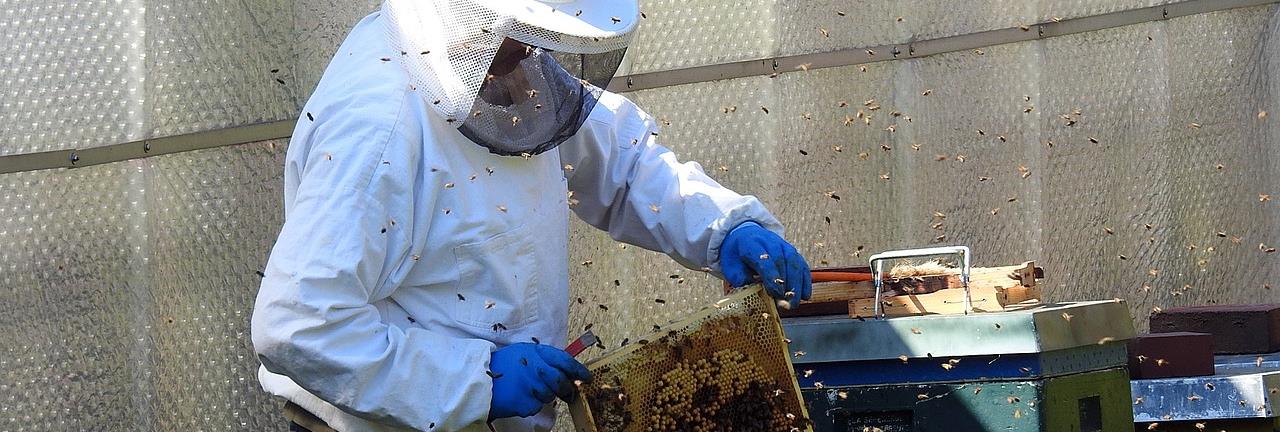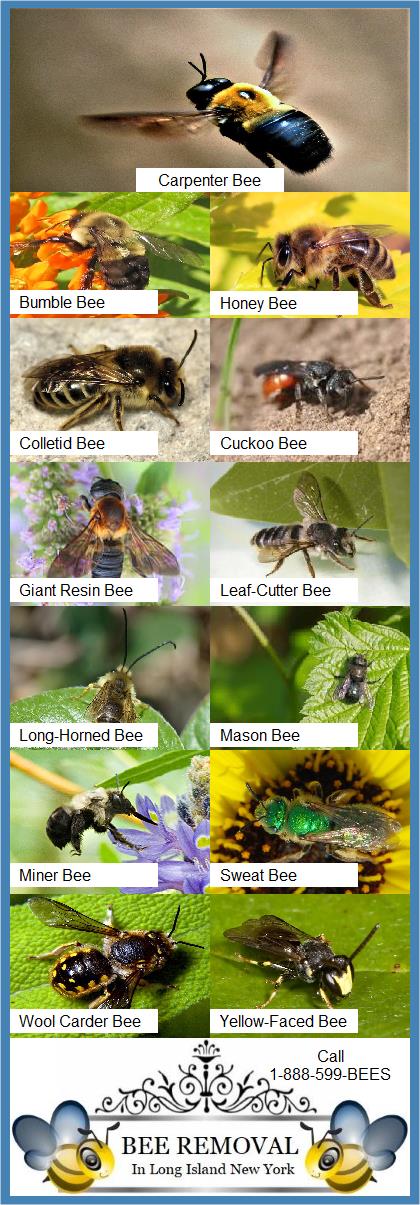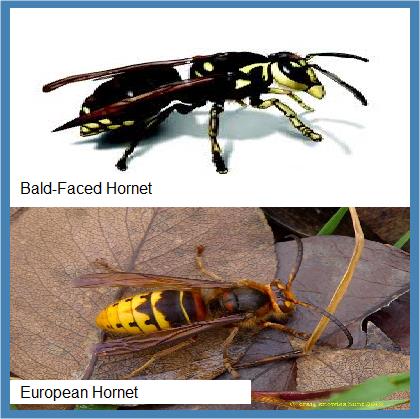Colletid Bees are also known as plasterer bees, cellophane bees, and polyester bees because the female bees plaster or line their brood cells with a cellophane-like material that is one of the polyesters. They are valuable pollinators of spring crops. Colletid bees are relatives of honeybees and bumblebees, but unlike their cousins, they are solitary bees. Each female bee excavates her own nest in which she lays eggs and lines the burrow's interior with a thin, glossy, translucent material. Developing larvae feed on bee bread stored in the brood chambers.
Yellow-faced Bees are also called masked bees. There are eighteen species of masked bees in New York, and they are often mistaken for small wasps because yellow-faced bees are hairless and black with yellow markings. The abdomens of masked bees are generally completely black without yellow markings, which helps differentiate them from wasps. The female bees transport pollen internally, in stomach-like organs, instead of carrying it on their legs or abdomens like most bees. Female yellow-faced bees construct nests in the stems of pithy stemmed plants such as elderberry and sumac. Masked bees are solitary bees and pollinators of blackberries, roses and can frequently be observed feeding on goldenrod.
Sweat Bees are also known as halictid bees. Sweat bees are attracted to perspiration. They are a diverse group of metallic and non-metallic bees that can vary significantly in appearance. Sweat bees may be solitary or eusocial, with most halictids nesting underground. Sweat bees are essential pollinators of many wildflowers and commercial crops.
Cuckoo Bees are solitary bees that often don't resemble classic bees in that they lack hair and may be mistaken for a wasp. The term cuckoo bee is used for various bee ancestries, which have evolved the brood parasitism behavior. Cuckoo bees are closely related to their host species, and their appearance and size are dependent upon the host species. Female cuckoo bees lay their eggs in the host's hive and leave, knowing their offspring will survive. None of the adult cuckoo bees have pollen baskets on their legs since they don't need to collect grains for their offspring.
Miner Bees are also known as chimney bees and mustached mud bees. These solitary ground-nesting black and yellow bees are often mistaken for bumblebees. Miner bees play an essential role in the pollination of gardens and serve an increasingly important role as honeybee populations decline.
Leaf-Cutter Bees are native bees who use their sharp edged mandibles to cut leaves and flower petals for nest construction. Leaf-cutter bees are solitary, cavity nesting bees and are essential pollinators of an extensive gamut of commercial crops and wildflowers.
Mason Bees are small bees who are essential pollinators of commercial crops, wildflowers, and several meadow, woodland, and wetland plants. Mason bees are tunnel nesting solitary bees. All female mason bees are queens that lay eggs and raise their offspring independently. Mason bees build individual nests in hollow reeds or other plant stems, preexisting cavities, or tunnels found in wood created by carpenter bees or wood-boring beetles. The mason bee's name originates from their practice of transporting mud to nesting areas to build structures where they will lay eggs.
Wool Carder Bees are often mistaken for yellowjacket wasps since both have bright yellow markings on their abdomen. However, wool carder bees are hairier and more robust in shape than yellowjackets. Wool carder bees are solitary, cavity nesting bees that use pre-existing cavities for brood cell construction. Potential bee nesting sites include holes in wood, such as those created by wood-boring beetles or other insects, hollow plant stems and reeds, and cracks and crevices in walls. Wool carder bees are so named because the female bees scrape and collect the soft downy hairs of fuzzy plants to construct nests for their offspring. Wooly materials are collected by female wool carder bees using their mandibles to scrape fuzzy trichomes from pubescent leaves, especially lamb's ear. While most bees transport pollen on their hind legs, this family of bees is unique because they carry pollen on their abdomen.
Bumble Bees are the only bees native to North America that are truly social and are essential pollinators of tomato plants and numerous other commercial crops. Bumblebees generally nest beneath woodpiles, in compost piles, and even inside the walls of Long Island homes. These flying insects are usually not aggressive but will defend their nest with repeated stings when threatened. Unlike other bees, bumblebees are active at cold temperatures and low light conditions.
Giant Resin Bees are native to eastern Asia and were accidentally introduced into the United States in the 1990s. Giant resin bees are solitary, opportunistic insects that use abandoned wood cavities for nesting, including holes in trees or tunnels created by carpenter bees. Giant resin bees will deposit a sticky resin in carpenter bee tunnels immobilizing them. Once immobilized, they attack the carpenter bees, killing them. Females will use existing carpenter bee cavities to lay their eggs because they can't gnaw through wood to create tunnels of their own.
Honey Bees are eusocial stinging flying insects, which live in colonies. Honey bee hives occur in cavities that are at least forty liters in volume and are ten or more feet above the ground. These bees provide essential pollination services for various crops and rank as the most frequent single species of pollinator for commercial crops worldwide.
Carpenter Bees are wood-boring insects which are also known as wood bees. Carpenter bees are the largest bees native to the United States. These bees resemble bumblebees but usually have a hairless, shiny abdomen. Carpenter bees are essential pollinators of flowers which excavate precisely rounded galleries in wood to raise their offspring.
Long-horned Bees are named for the male bee's extra long antennae. On Long Island, Long-horned bees can be seen visiting sunflowers in July and August.



